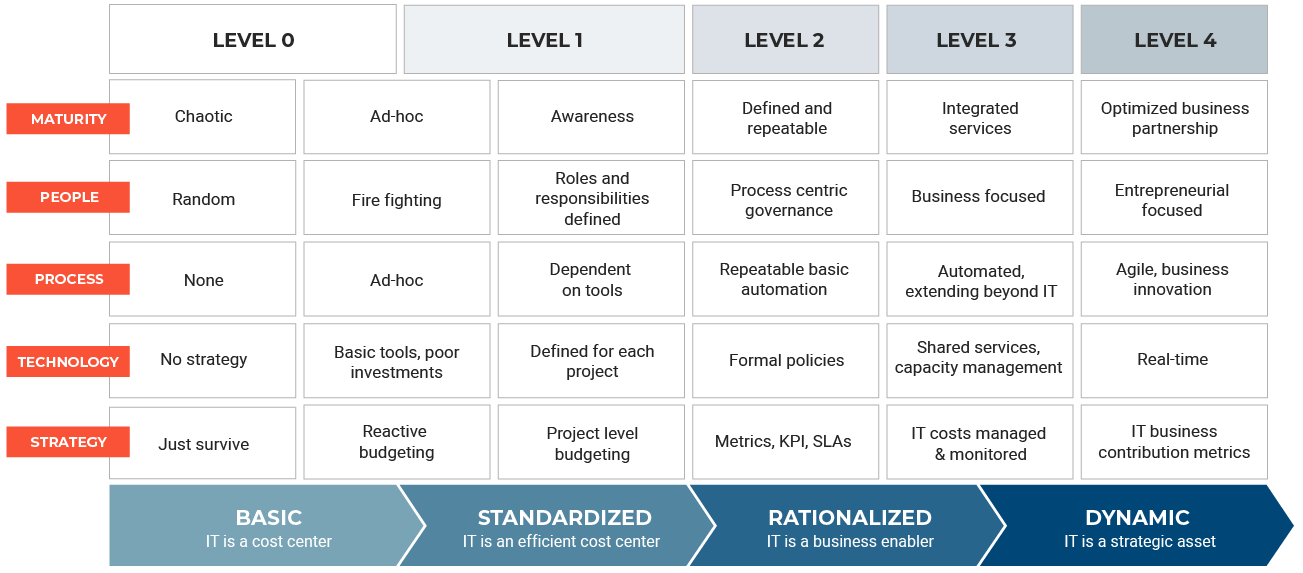February 21, 2022 - by Synoptek
As the race towards around digital transformation gets increasingly competitive, organizations are scrambling around to implement the latest technology innovations. But does being at-par with the latest trends guarantee transformation success? Unfortunately, not! Undoubtedly, embracing technology is essential to stay relevant, improve operational efficiency, and keep up with customer expectations; but determining which technologies to implement or what tools to embrace plays a more important role and this eventually depends on your tech maturity. The systems and solutions you implement must be in-line with whether you’re a digital starter, literate, performer, or leader!
Why Assessing Your Tech Maturity is Critical?
In today’s digitalized business environment, adopting a handful of modern technology solutions is not enough for transformation; true transformation is a continuous journey, and requires organizations to carefully assess their tech maturity to understand where they currently are on the matrix and learn how they can build core competencies to go up the model.
Maturity models are a proven approach for leaders to improve the performance and effectiveness of their organizations. By assessing people, processes, technology, and IT alignment with the core business, executives can drive attention to aspects where the greatest impact can be made. Such assessment not only provides a clear picture of the current state, it also helps define the “to-be” state the organization seeks to achieve while facilitating them to make technology an enabler for the business.
At the same time, a thorough and detailed assessment can help organizations in:
- Prioritizing goals and determining tools and technologies to meet business objectives in time and within budget
- Curating a robust strategic vision that aligns with digital transformation objectives, evolving trends, and customer demands
- Ensuring a flexible and secure infrastructure with intelligent workflows that lead to employee and customer satisfaction
- Improving communication between employees at all levels and enabling the accomplishment of shared goals
- Identifying bottlenecks that restrict growth while also recognizing areas for improvement
- Ensuring the business reacts and responds to changing trends and patterns with increased agility
Where Does Your Organization Stand in the Tech Maturity Matrix?
Where you currently stand in the tech maturity matrix is extremely important to determine where you want to go. Since the only way to transform business operations is by maturing your IT, you need to have a detailed understanding of different stages of tech maturity and know how your people behave, how your processes are, and what your strategies state. Having said that, let’s understand the different stages of tech maturity:

Level 0
If your organization has purchased a handful of systems and tools but has very little direction or planning beyond implementation, your tech maturity is at Level 0. At this level, tech management is either extremely chaotic or ad hoc, and there are no real plans, policies, or procedures in place for IT management. For any issues, people tend to reach out to different external and internal resources – because there is no centralized helpdesk. Employees will often download applications at their own discretion, exposing the organization to risk of data loss. At the same time, CTOs do not believe in investing in preventative maintenance and management of IT.
Level 1
If you have put up formal structures in place to deal with the implementation, management, and support of your tech systems, you are at Level 1 of the tech maturity model. At this stage, although there is decent awareness about the need for and benefits of technology, the approach is still very reactive. Different departments use different systems, data structures, protocols, and even though problems are handled in a formalized manner, it ends up in extreme firefighting and lost time.
Level 2
If your technology processes are defined and repeatable, and you take the effort to make proactive decisions, you are at Level 2. At this stage, you will be eager to acquire new skills while constantly working towards predicting and even preventing tech problems. Your organization has invested in standardized and centralized platforms that breaks down departmental silos, and your focus has shifted from just being efficient to being effective. You place great emphasis on enabling cross-functional and multi-departmental processes to drive holistic business integration.
Level 3
Organizations at Level 3 of the tech maturity matrix drive efforts in integrating services, automating workflows, and monitoring technology costs. You are constantly looking to maximize value from information, technology, and technology-based initiatives and consider IT as an asset to the business. You measure IT in terms of the fulfillment of your Service Level Agreement (SLA) and incorporate IT into every department’s P&L. You are also focused on improving capacity planning and management to lower overall costs and have strong information governance policies in place.
Level 4
You are at Level 4 of tech maturity if your people are focused, your processes are agile, and your technology systems deliver insights in real-time. Technology is fully integrated into every operation of the business, and your services are inextricably linked to specific business processes. You no longer report performance in terms of uptime or other technological metrics; instead, you measure success in terms of overall operating profitability of the company. You are constantly acquiring new skills, have programs in place for continuous service improvements, and seek optimized business partnerships with tech vendors.
As the pressure to adopt and embrace new technological innovation intensifies, technology maturity models offer a great benchmark for organizations to understand where they currently stand and constantly aspire to advance up the matrix. Since continuous transformation requires organizations to do new things in new ways and acquire new skills and processes, partnering with a Global IT Outsourcing Partner can help you establish carefully planned strategies to set goals and determine steps to be taken to progress to the next level of tech maturity.
